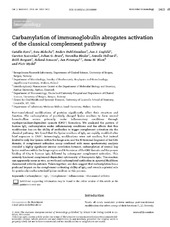| dc.contributor.author | Koro, Catalin | en_US |
| dc.contributor.author | Bielecka, Ewa | en_US |
| dc.contributor.author | Dahl-Knudsen, Anders | en_US |
| dc.contributor.author | Enghild, Jan J | en_US |
| dc.contributor.author | Scavenius, Carsten | en_US |
| dc.contributor.author | Brun, Johan G | en_US |
| dc.contributor.author | Binder, Veronika | en_US |
| dc.contributor.author | Hellvard, Annelie | en_US |
| dc.contributor.author | Bergum, Brith | en_US |
| dc.contributor.author | Jonsson, Roland | en_US |
| dc.contributor.author | Potempa, Jan | en_US |
| dc.contributor.author | Blom, Anna M. | en_US |
| dc.contributor.author | Mydel, Piotr Mateusz | en_US |
| dc.date.accessioned | 2015-09-22T12:27:44Z | |
| dc.date.available | 2015-09-22T12:27:44Z | |
| dc.date.issued | 2014-11 | |
| dc.identifier.issn | 0014-2980 | |
| dc.identifier.uri | https://hdl.handle.net/1956/10499 | |
| dc.description.abstract | Post-translational modifications of proteins significantly affect their structure and function. The carbamylation of positively charged lysine residues to form neutral homoitrulline occurs primarily under inflammatory conditions through myeloperoxidase-dependent cyanate (CNO−) formation. We analyzed the pattern of human IgG1 carbamylation under inflammatory conditions and the effects that this modification has on the ability of antibodies to trigger complement activation via the classical pathway. We found that the lysine residues of IgG1 are rapidly modified after brief exposure to CNO−. Interestingly, modifications were not random, but instead limited to only few lysines within the hinge area and the N-terminal fragment of the CH2 domain. A complement activation assay combined with mass spectrometry analysis revealed a highly significant inverse correlation between carbamylation of several key lysine residues within the hinge region and N-terminus of the CH2 domain and the proper binding of C1q to human IgG1 followed by subsequent complement activation. This severely hindered complement-dependent cytotoxicity of therapeutic IgG1. The reaction can apparently occur in vivo, as we found carbamylated antibodies in synovial fluid from rheumatoid arthritis patients. Taken together, our data suggest that carbamylation has a profound impact on the complement-activating ability of IgG1 and reveals a pivotal role for previously uncharacterized lysine residues in this process. | en_US |
| dc.language.iso | eng | eng |
| dc.publisher | Wiley | eng |
| dc.rights | Attribution CC BY-NC-ND | eng |
| dc.rights.uri | http://creativecommons.org/licenses/by-nc-nd/4.0/ | eng |
| dc.subject | Carbamylation | eng |
| dc.subject | IgG1 | eng |
| dc.subject | Complement | eng |
| dc.subject | Inflammation | eng |
| dc.subject | Rheumatoid arthritis | eng |
| dc.title | Carbamylation of immunoglobulin abrogates activation of the classical complement pathway | en_US |
| dc.type | Peer reviewed | |
| dc.type | Journal article | |
| dc.date.updated | 2015-07-30T07:29:32Z | |
| dc.description.version | publishedVersion | en_US |
| dc.rights.holder | Copyright 2014 The Authors | |
| dc.identifier.doi | https://doi.org/10.1002/eji.201444869 | |
| dc.identifier.cristin | 1232198 | |
| dc.source.journal | European Journal of Immunology | |
| dc.source.40 | 44 | |
| dc.source.14 | 11 | |
| dc.source.pagenumber | 3404-3412 | |

